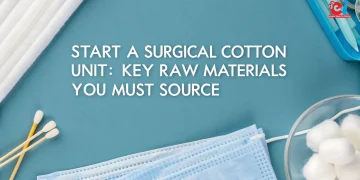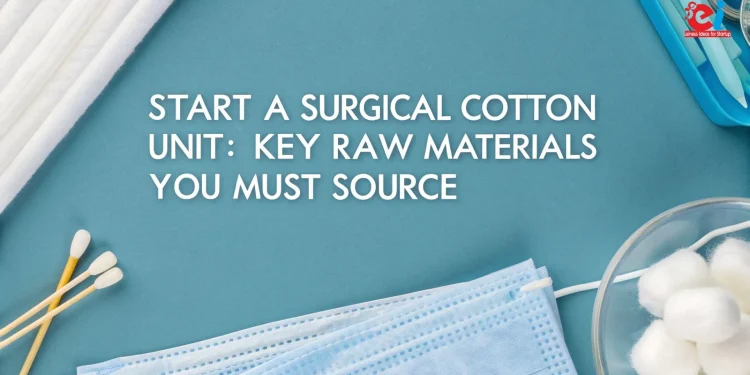In the healthcare industry, surgical cotton is of extreme necessity. It covers clinics and hospitals, meanwhile, it can even be found in first aid kits and pharmacies. It serves many purposes such as taking care of wounds, cleaning fluids, applying antiseptics, and much more. The product is crucial because it can easily provide soft, sterile and highly absorbent materials.
Due to the rise in healthcare facilities, along with medical outreach and awareness programs in rural areas, the demand for surgical cotton both internationally and in India is increasing. For entrepreneurs, institutional suppliers, and manufacturers, this is a wonderful opportunity. Although, ensuring high-quality surgical cotton is made requires great attention used in sourcing raw materials, each having to be selected with precision, quality tested, and processed under very strong rules.
This article discusses medical grade cotton, along with the chemical agents employed in the bleaching procedure, as well as the appropriate packaging for the finished item which must be of the highest quality to fulfill pharmaceutical standards.
The Role of Raw Materials in Surgical Cotton Manufacturing
Surgical cotton is a type of absorbent or medical cotton that requires rigorous processes of purification, bleaching, and drying to obtain the necessary levels of sterility, absorbance, purity, and whiteness. Unlike regular cotton used for textiles, surgical cotton goes through multiple stages (i.e., sutaging, absorbent bleach, dour aging, sparaging, etc.) that require specific raw materials such as chemicals, packaging, and cotton lint. Each of these steps is enabled by meticulous raw materials like cotton lint, chemicals for treatment, and packaging that sustain sterility.
The properties of absorbent surgical cotton, which include softness, fiber length, and absorbency, are highly dependent on the quality of the raw materials used. Additionally, the quality impacts the regulatory and market acceptance. It is evident that using just one batch of subpar grade input can bring catastrophic consequences such as product rejection, reduced trust, and trust, and a more severe public safety concern in the case of end users. Hence, this clearly shows that procurement is more than an activity in a business, it serves as a competitive advantage in this case for the industry.
Cotton lint is the most important raw material in surgical cotton manufacturing. It can also be called raw cotton, which is the fiber gotten from the cotton plants ginned separating the seeds. However, not all cotton is suitable for surgical use.
Surgical cotton hinge on the factors like cotton quality, which is long-staple, whitish, and with low impurities along with high cellulose content. Additionally, the cotton must also be devoid of seeds, husks, leaves, and oils. Furthermore, wax and fat are to be kept at low levels for improved absorption post-processing.
Along with India standing out as one of the foremost cotton producers. The state of Maharashtra, Gujarat, Telangana and Punjab serve as important suppliers. Cotton ginning units have raw cotton, while cotton federations and authorized dealers offer it too. It is crucial, though, that manufacturers establish the cotton’s compliance with IP/BP/USP regulations and confirm its pre-cleaning, de-linting, and de-boarding prior to entering the production line.
There are some manufacturers who source cotton from regions renowned for finer fiber grade like Gujarat’s Shankar-6 variety, owing to its superb spinnability and fibrility leading to smoother, fluffier surgical cotton pads.
Related: Surgical Cotton Manufacturing Business
Chemical Agents Used in the Purification and Bleaching Process
The presence of natural oils, waxes, and pigments in raw cotton hinder the greatly required absorbency and sterilization. Furthermore, for surgical cotton, thorough bleaching coupled with purification through chemical treatment is required. Bleaching aids and chemical additives become of highest necessity at this stage, marking this as the second category of raw materials.
The primary chemicals used include:
- Sodium Hypochlorite (NaOCl) or Hydrogen Peroxide (H₂O₂):
The two most important bleaching chemicals that are used to decolorize cotton and remove organic pigments. Hydrogen Peroxide is preferred because it is more environmentally friendly and gives a more even whitening effect. - Caustic Soda (Sodium Hydroxide – NaOH):
Used to vie natural fats and waxes from the cotton fibers at the scouring stage which makes them more water absorbent. - Wetting Agents and Detergents:
These open the fibers and break surface tension, increasing the removal of cottonous matter and chemicals on the fibers’ surfaces. - Acids:
Neutralization stage in dilution. Hydrochloric or sulfuric acid is used to balance in and alkali treatment. - Optional Antiseptic Additives:
A small quantity of antiseptic or disinfectant can be added to some premium products sterile post packaging to boost the cotton’s germ-resistance.
All chemicals have to be from certified suppliers who have undergone pharma-grade scrutiny for consistency, technical specifications, and safety data sheets (SDS). Proper handling, storage, and wastewater treatment are [required by] environmental and pharmaceutical regulations.
Packaging Materials and Sterility Assurance
The surgical cotton undergoes a bleaching step which is then followed through drying and fluffing. After that, she can begin the packaging and branding interface with the product. Packaging plays a critical role in maintaining sterility and sanitation of the surgical cotton. It also plays an important part in transport, tourism, and shelf life. The choice of newer markets such as bulk hospital supply, retail pharmacy sales, or institutional care give her preference sample differences set an expectation to meet.
Some of the hurricane protective blankets include:
- The Widely Used Primary Packaging for Polybags:
LDPE or HDPE Polybags manufactured Heat-sealed transparent or opaque plastic. These are distributed to cotton rolls of 50g, 100g, 200g, 400g, 500g sizes. - Blister or Flow Wraps:
Used on steril packs and cotton balls defined for single usage or surgical packages but meant for singular usage. - Composite Wrapping:
Composite wrapping and paper-based with cunning openings gain traction in eco-conscious markets on trying to use biodegradable paper wraps or kraft paper combined with laminated liners. - Carton Boxes or Corrugated Boxes:
Gain traction. Our hope described above but with claimed moisture resistant but also aid in protecting fragile contents from rough logistics while sharpening. Sets for secondary packaging. They also offer these to add strength captured above school-boarded with survival grade.
Carton boxes or outer-but-not-outer stroke used for protective shipping slash secondary aids in to alsoatori forte serve as containing the master cables.
FSSAI, CDSCO, bases norms governing agreement of contains CDSCO and dating marking labeling associated placed must do so such servicing bandaged of equipment on weight, batch handling such as set advanced FPSA USA.
Correct packaging keeps the surgical cotton’s absorbency, whiteness, and contamination-free qualities intact for a period of up to two years.
Related: Growing Demand of Surgical Cotton
Vendor Selection and Assuring Quality
For vendors planning to fabricate surgical cotton commercially, it is pertinent to strategically select raw material vendors. Having a reliable vendor network mitigates supply uncertainties, batch consistency, and assists in long-term costing.
Vendors meeting the minimum requirements of having an ISO certificate and experience in supplying to pharma or medical supplies are ideal. Acceptance of raw cotton for processing is contingent upon the completion of quality checks such as fiber length measurement, ash content, absorbency tests, and microbial load on the cotton in question.
An in-house quality control laboratory will verify the Indian Pharmacopoeia (IP) or British Pharmacopoeia (BP) compliance for other surgical equipment. For certain customers, such as hospitals, government tenders or export markets, clear documentation for traceability and audit readiness is equally important.
Conclusion: Building a Reliable Foundation for High-Quality Surgical Cotton
The success of a surgical cottons manufacturing unit starts not at the production floor but with raw material sourcing. Only when the input materials—cotton, chemicals, and packaging—are carefully selected, tested, and certified, can the end product meet the rigorous expectations of the healthcare industry.
In a sector where quality equals safety, sourcing is not just a procurement task—it’s the first step in delivering a product that can be trusted in the most critical medical environments. Entrepreneurs entering the surgical cotton business must treat raw material selection with the same diligence as they would apply to branding, marketing, or sales.
By securing reliable sources of medical-grade cotton, choosing high-purity chemicals, and investing in sterile, informative packaging, manufacturers can ensure that every roll of cotton they produce carries with it the promise of purity, safety, and clinical reliability.Niir Project Consultancy Services (NPCS) provides turnkey solutions, raw material sourcing strategies, vendor listings, machinery support, and market feasibility reports for surgical cotton manufacturing businesses.


























